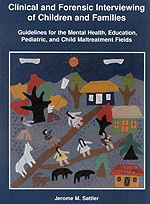|
JEROME M. SATTLER, PUBLISHER, INC. |
||
| Reviewers' Comments |
PREFACE
Clinical and Forensic Interviewing of Children and Families is designed to help students and professionals in human services fields become competent clinical assessment and forensic interviewers. The impetus for writing this text was my renewed appreciation of the importance of the interview as an assessment tool. The human services field is evolving rapidly. More and more children are being referred for custody evaluations, maltreatment, depression, suicide attempts, and health-related conditions. Homelessness, AIDS, substance abuse, and crisis intervention have become extremely important areas for mental health professionals. The increase in managedhealth care programs places greater demands on all clinicians to provide time-limited, focused, and cost-effective service. There is less time and money for intense diagnostic study, despite the potential benefits. A text that addressed these topics was clearly needed. This book is based on the philosophy that one cannot be a competent clinical assessment or forensic interviewer unless he or she has the relevant information about the child's presenting problem, as well as knowledge of the interventions that might help the child and family. Therefore, in this text, you will find information about the major problem areas encountered by children and their families and about interventions, along with suggestions for conducting interviews. You should consult additional references about the child's problem areas, as needed. This book will benefit students and professionals in all human services fields, including social work, clinical psychology, counseling psychology, school psychology, rehabilitation psychology, health psychology, pediatric psychology, psychiatry, education, and speech therapy. In addition, professionals in such allied fields as medicine, nursing, law, and law enforcement have much to gain from reading it. This text provides both theoretical and practical guidelines to help students and professionals develop skills in interviewing children, adolescents, parents, families, and teachers. One entire section of the book is devoted to the assessment of child maltreatment. Two considerations led me to give extensive coverage to this area. First, child maltreatment is of increasing concern to human services workers, as billions of dollars are being spent by governmental agencies for the investigation, care, and treatment of children who are alleged to have been maltreated or who have been maltreated. Second, the interview plays a critical role in the assessment of child maltreatment. The more you know about the pitfalls of interviewing in cases of child maltreatment, the more effective you will be in interviewing children and in presenting your findings in any criminal proceedings, in which interview techniques are sometimes challenged. The material in Section V will give you a foundation for understanding child maltreatment and a foundation for conducting child maltreatment interviews. To conduct effective clinical assessment or forensic interviews with children and adolescents, you need to know about normal children and their families and about children who have developmental or behavioral problems or special needs. Although this book presents normal developmental landmarks and reviews features associated with several behavioral and medical problems found in children, I encourage you to read appropriate texts in normal child development and child psychopathology if you are unfamiliar with these areas. |

